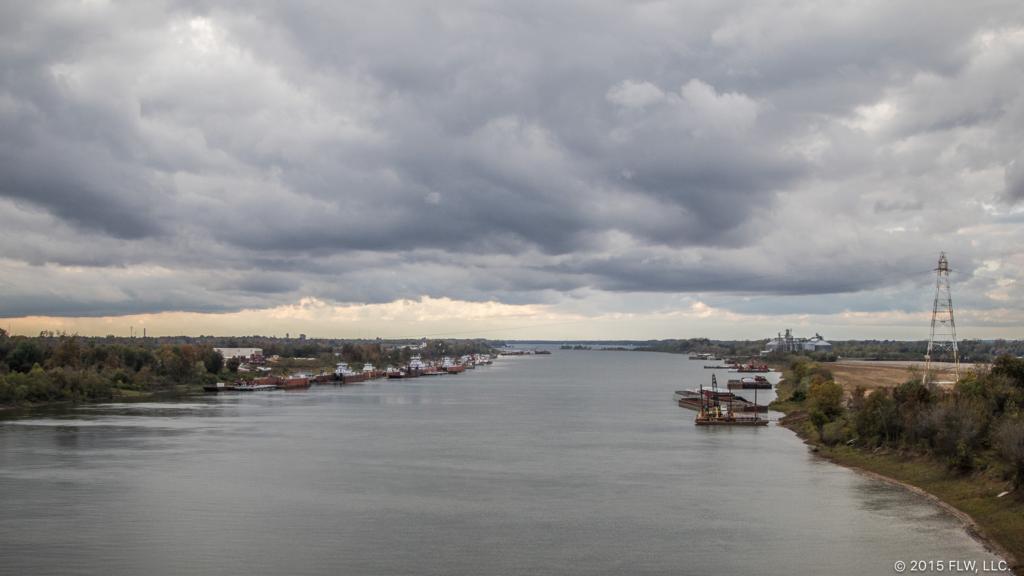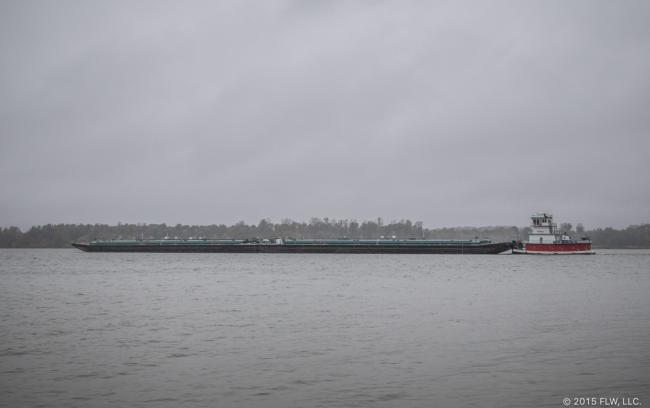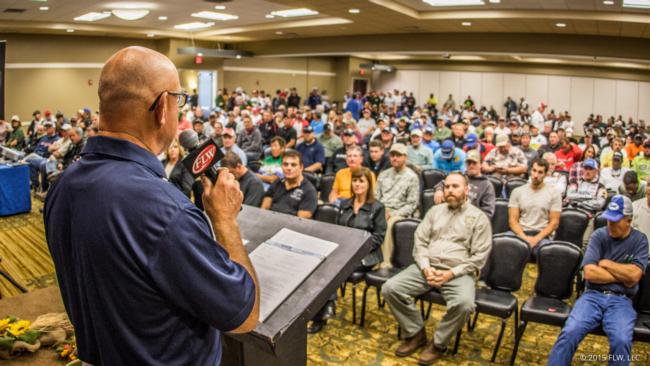Rain Raises the Bar
Mud, current, pressure and three species challenge Rayovac FLW Series Championship anglers

When the 171 pros and their co-angler equivalents roll out of Paducah, Ky., onto the Ohio, Tennessee and Cumberland rivers on Thursday morning they’ll have to contend with conditions that are totally different from practice. Hosted by the City of Paducah and the Paducah Convention and Visitors Bureau, the Rayovac FLW Series Championship is the last event of the season for many and will be the gateway to the 2016 Forrest Wood Cup for 10 pros come Saturday afternoon.
Though the anglers take off in the Paducah pool of the Ohio River, there is quite a bit of water elsewhere to fish. Besides fishing right by Paducah on the Ohio, the competitors could choose to run upstream and lock into the Smithland Pool, a big pool with more backwaters and wood cover than elsewhere. It stretches from Smithland, Ky., up past the Indiana border to Uniontown, Ky.
The Tennessee and Cumberland rivers would also play. Neither is particularly long, but the stretches running from below Kentucky Lake and Lake Barkley and their respective dams are both productive fisheries and house the biggest smallmouths in the system.
You can find an in-depth rundown of the various rivers here.
The following factors figure to come into play this week:
- Heavy rainfall, both prior to and during the tournament
- Three species of bass
- A large tournament field of 171 boats
- A cold front
The Rain
One of the major factors in play is the potential for rising water due to the rain that fell over the region from the end of the third practice day on Monday through the night of the fourth and final practice day on Tuesday. Depending on how the rain muddies the various creeks and inflowing rivers, things could get pretty interesting.
“One of the things I did yesterday [Tuesday] was I went and checked my Smithland Pool fish,” says Tommy Williams, a longtime stick who frequents the Ohio just a few pools upstream. “Those creeks were starting to blow out, the current was starting to run pretty good and the wind was bad. I ran almost 48 miles up the river toward Uniontown. The further I went the harder the current was coming out of the creeks. That’s death on the river.
“Historically, this time of year on the Ohio the fish stack up in the mouths of creeks,” Williams explains. “That’s what I had going on up there. You could catch numbers there, but they weren’t but small fish. When the water started pulling out yesterday I couldn’t catch them, so I just wrote it off.”
Toby Corn, who hails from West Frankfort, Ill., and calls the Ohio, Cumberland and Tennessee rivers home, thinks the rain and added current could both help and hurt the bite.
“This water coming up is gonna definitely hurt the backwater guys,” Corn says assuredly. “I don’t know how muddy it’s gotten, but it’s gonna get muddy. That helps the Tennessee and the Cumberland. There’ll be more water flowing there, and it will be clean water. That makes the smallmouths bite.”
There’s a small chance that the water makes a truly large rise if the engineers at Kentucky and Barkley dams decide to release a lot of water from the reservoirs up above. If that happens, it’s likely that few in the field will have any prior experience on the system in those conditions to confidently predict where the fish will go. Happily, the chances of that happening are slim, and the main concerns are that the increased current could reposition bass found in practice and that certain areas could be blown out with mud.
In the latter case, Keystone Light pro Jeff Sprague thinks locals like Corn and Williams could be happy.
“I think that because of how the river has changed since practice ended a local guy will have an advantage,” Sprague says. “He’ll know where the fish will move when the water comes up. The fish here are used to water moving around, and someone who knows how they move with it could do well.”
Three Species of Bass
Besides being home to a tremendous population of sheepshead, gar and Asian carp, the rivers also have some big smallmouths and plenty of largemouth and spotted bass. All three species appear to have winning potential.
“If I get a good boat number I’m going to gamble and try and catch smallmouths,” says Corn. “That’s how it’s going to be won. I think half the top 10 will have three or four smallmouths in their bags on day one. If I don’t get a good draw then I’ll just scrap around. There are about six smallmouth spots on each river [the Cumberland and Tennessee]. If you get on one of them all day, you might only get three or four bites, but they’re all going to be 3 or 4 pounds.”
Williams plans on taking a safer route.
“I’m looking for four spotted bass and one big largemouth,” says the veteran river rat. “I’ve been catching a good limit of fish, sometimes two limits of fish, every day. It’s a typical river deal; you drop the trolling motor and go and cover as much water as you can. I think 10 pounds a day makes the cut, but that’s probably not going to win it. For that you’ll have to have a big fish or two come into play one day.”
“I’ve come here a couple times on days off when I’ve had tournaments on Kentucky Lake and absolutely smashed the smallmouths,” adds Sprague, who drove up from his home in Texas for the event. “I mean, we’ve caught 20 pounds before. But I haven’t found any of those fish in practice. For the tournament, I’m hoping to see some smallmouths and some spots. I think the spotted bass will be players. They’re healthy looking and extremely filled out.”
Crowds and a Cold Front
Fishing pressure impacts every tournament, but the predictions for this one are all over the board. According to Corn, the smallmouth spots are at a premium, but even if crowded they could still have an impact. The tailwater areas were crowded in practice and likely will get plenty of attention. There’s also the chance (not really a bad one) that someone has found fish in a location not predicted by history that he can have to himself.
Fishing pressure has taken a toll in other ways too. In the Smithland Pool, for instance, anglers report that it’s not just the rain that’s muddied the creeks. The increase in boat traffic has also contributed to the turbidity.
Finally, there’s a cold front headed in to make things a little tougher. The forecast for day one is cool and crisp, with a low of 36 degrees in the morning – classic fall weather that will likely have the fish a little sluggish.
Regardless of the obstacles, this week 10 pros will punch their tickets to the 2016 Forrest Wood Cup on Wheeler Lake. That in itself is reason enough to pay attention as a big field of very talented anglers looks for the winning fish on a tricky and interesting system of rivers.

